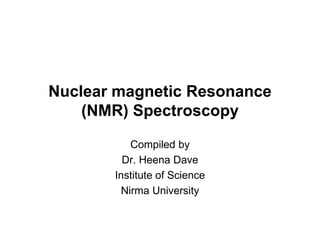The document discusses nuclear magnetic resonance (NMR) spectroscopy. It provides information on:
1) NMR spectroscopy gives structural information about molecules, including the number and types of atoms. It can determine 3D structures of proteins and nucleic acids.
2) Applications include studying protein dynamics, hydrogen bonding, and protein-ligand interactions. Magnetic resonance imaging uses NMR principles to detect tumors.
3) NMR signals provide information on the chemical environment and number of equivalent protons in a molecule.



















































